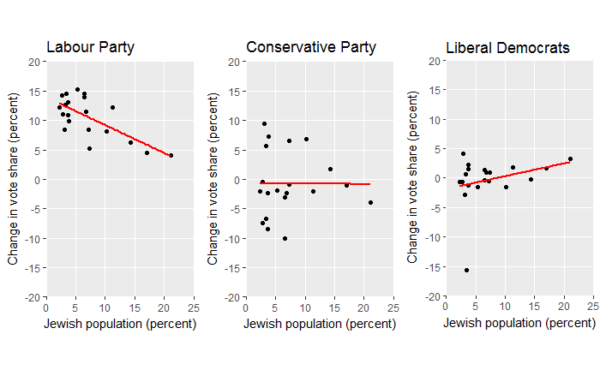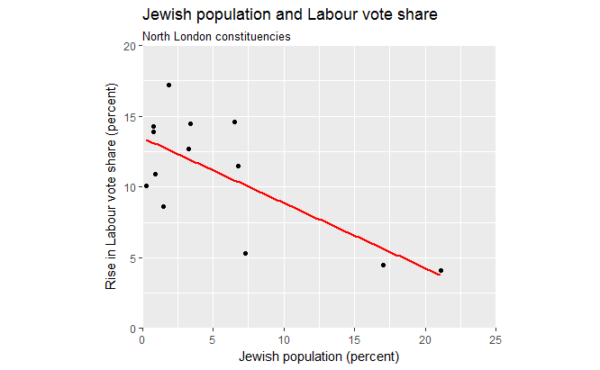Last week, I published a blog post showing that North London constituencies bucked the national trend by swinging less heavily towards Labour than might otherwise have been expected. I have since repeated the analysis, looking at changes in votes for the Labour Party, Conservative Party, and Liberal Democrats in the twenty British constituencies with the highest Jewish populations. The findings of that analysis are consistent with the view that many British Jews who had previously voted Labour turned away from the party in response to its continued mishandling of its ongoing antisemitism crisis, but — contrary to some indications that ‘the Tories were likely to take huge swathes of Jewish votes’ — they did not turn towards the Conservative Party. Instead, such voters seem more likely to have voted Liberal Democrat.
Month: June 2017
The electoral cost of left wing antisemitism
EDIT (2 Jul 2017): See also my subsequent analysis of the Labour, Conservative, and Liberal Democrat vote in the 20 British constituencies with the highest Jewish populations
EDIT (12 April 2019): I also analysed 2018 local election results in Barnet: the local authority with the highest Jewish population in the UK. This analysis was reported on the front page of the Jewish Chronicle on 10 May 2018.
The UK’s 2017 general election campaign was marred by overt racism against Jews on the part of some supporters of Jeremy Corbyn, perhaps most dramatically expressed in the erection of a vast antisemitic banner in a central location in the city of Bristol. Moreover, it came hard on the heels of the Labour Party’s failure to discipline Corbyn’s long-term ally, Ken Livingstone over his appalling historical distortions with regard to Adolf Hitler and the Zionist movement.
The Labour leadership is riding high at the moment, thanks to its less-severe-than-expected defeat in the face of an utterly shambolic Tory campaign. However, there’s been some discussion as to the electoral cost of its failures with regard to the Jewish community (see e.g. Marcus Dysch in the Jewish Chronicle).
Can we put a figure on that cost? If we look at voting in the part of the country with the highest Jewish population, we find that two percent more Jews in a constituency implies a roughly one percent smaller rise in Labour’s vote share.
Continue reading “The electoral cost of left wing antisemitism”

